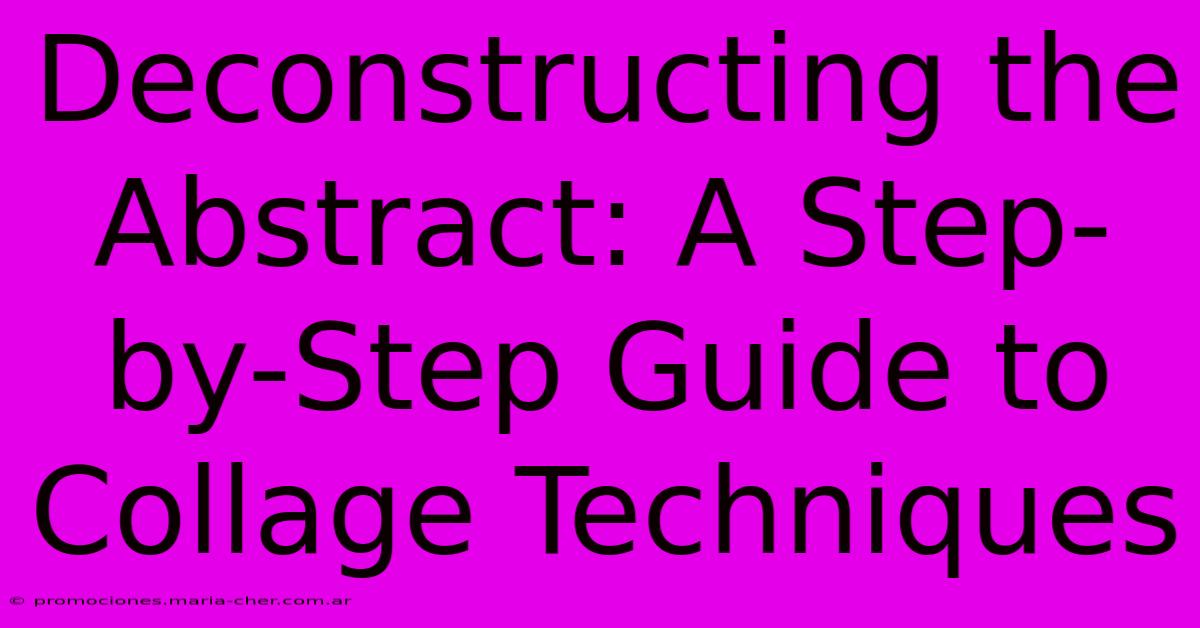Deconstructing The Abstract: A Step-by-Step Guide To Collage Techniques

Table of Contents
Deconstructing the Abstract: A Step-by-Step Guide to Collage Techniques
Collage. The word itself conjures images of vibrant textures, unexpected juxtapositions, and a delightful sense of creative chaos. But behind the seemingly effortless beauty of a finished collage lies a process – a thoughtful deconstruction and reconstruction of images and materials. This guide will walk you through the steps, offering techniques to help you unlock your own abstract collage potential.
Understanding the Abstract in Collage
Before diving into the techniques, let's define our goal. Abstract collage isn't about representing reality; it's about expressing emotion, exploring form, and creating visual narratives through non-representational means. It's about letting go of the need for perfect representation and embracing the freedom of experimentation. This allows for a unique and personal artistic expression.
Key Elements of Abstract Collage:
- Texture: The interplay of rough and smooth, thick and thin, adds depth and visual interest. Experiment with different materials to achieve a range of textures.
- Color: Bold color combinations can create powerful emotional responses. Don't be afraid to experiment with contrasting or complementary hues.
- Shape and Form: The arrangement of shapes and forms within the collage dictates the overall composition and visual flow. Consider negative space as much as positive space.
- Juxtaposition: Placing unexpected elements together can spark intrigue and create a sense of visual surprise. This is where the true magic of abstract collage happens.
Step-by-Step Guide to Creating Your Abstract Collage
Now, let's get our hands dirty! Here's a step-by-step process to guide you through creating your own abstract collage masterpiece:
1. Gathering Your Materials: The Foundation of Your Collage
The beauty of collage lies in its versatility. Gather a diverse range of materials to build your palette:
- Paper: Magazines, newspapers, books, wrapping paper, colored paper, even receipts – anything with interesting textures, colors, or patterns.
- Fabric Scraps: Denim, silk, cotton, felt – textures are key!
- Found Objects: Buttons, ribbons, string, tickets, dried flowers – incorporate unexpected elements for added intrigue.
- Paints and Inks: Add splashes of color or create backgrounds using acrylics, watercolors, or inks.
- Adhesives: Use a strong adhesive like Mod Podge or glue stick, depending on your materials.
- Tools: Scissors, a craft knife, a ruler (optional for precise cuts).
2. Creating a Foundation: The Base for Your Vision
Start with a sturdy base. This could be a canvas, a piece of heavy-weight paper, or even a piece of wood. Consider the size and shape you desire for your final piece. You can even create a textured background using paint or other materials before adding your collage elements.
3. Deconstructing and Selecting: Finding the Right Pieces
This is where the fun begins! Start sifting through your materials, looking for colors, textures, and shapes that spark your interest. Don't be afraid to tear, cut, and rip your materials into different shapes and sizes. The more irregular and unexpected the shapes, the more abstract your collage will be.
4. Arranging and Experimenting: Finding the Perfect Balance
Before you start gluing anything down, arrange your chosen pieces on your base. Experiment with different layouts, playing with color, texture, and shape. This step is crucial for achieving a balanced and visually appealing composition. Don't be afraid to move things around until you find something that feels right.
5. Adhering and Refining: Bringing Your Vision to Life
Once you're happy with the arrangement, carefully glue down each piece, ensuring a strong bond. Take your time, and work in sections to avoid accidentally shifting other elements. After your glue has dried, you may choose to add further layers, refining the piece as you go.
6. Adding Finishing Touches: The Final Flourishes
Once everything is firmly adhered, you can add final touches. This could involve adding more paint, ink, or other embellishments. Consider adding a protective sealant to preserve your artwork and enhance its vibrancy.
Expanding Your Abstract Collage Techniques
Once you've mastered the basics, explore these advanced techniques:
- Layered Collage: Build depth and complexity by layering different materials on top of one another.
- Mixed Media Collage: Incorporate paint, ink, and other mediums alongside your paper and fabric elements.
- 3D Collage: Add dimensionality with objects that protrude from the surface.
Abstract collage is a journey of experimentation and self-discovery. Don't be afraid to make mistakes; they often lead to unexpected and beautiful results. Embrace the freedom of the process, and let your creativity flow! Remember, the key is to enjoy the process and express yourself authentically. So grab your materials and start creating!

Thank you for visiting our website wich cover about Deconstructing The Abstract: A Step-by-Step Guide To Collage Techniques. We hope the information provided has been useful to you. Feel free to contact us if you have any questions or need further assistance. See you next time and dont miss to bookmark.
Featured Posts
-
Unleash The Power Of Remote Work Discover The Ultimate Remote Office Space
Feb 08, 2025
-
Unveiling The Radiant Glow Hot Pink Flowers For A Mesmerizing Wedding Bouquet
Feb 08, 2025
-
380 Lexington Ave Nyc The Perfect Hub For Business Pleasure And Everything In Between
Feb 08, 2025
-
Transform Ordinary Shots Into Extraordinary The Insiders Guide To Mastering Photo Enhancement
Feb 08, 2025
-
Paid Newsletters The Lucrative Path To Financial Freedom
Feb 08, 2025
